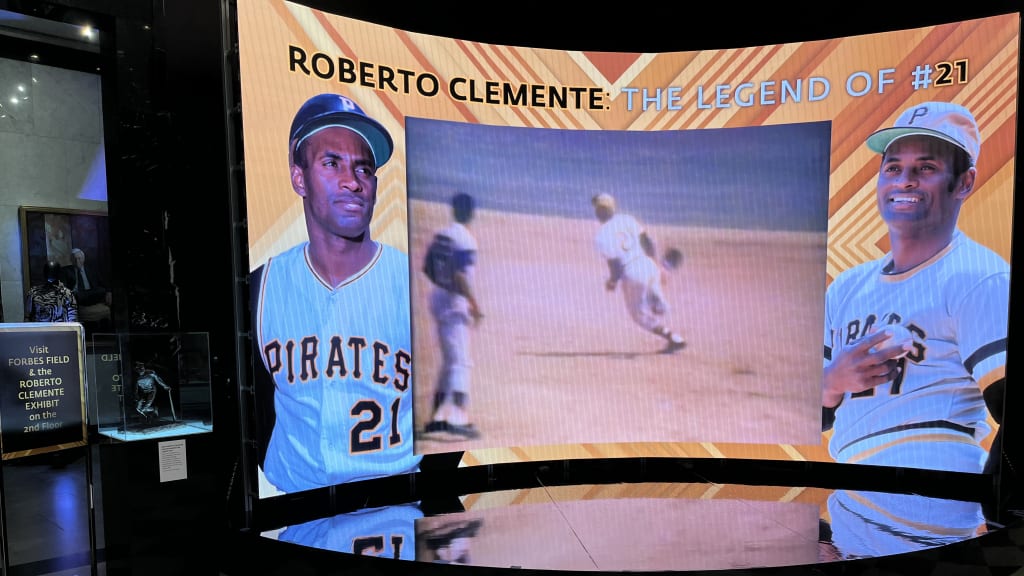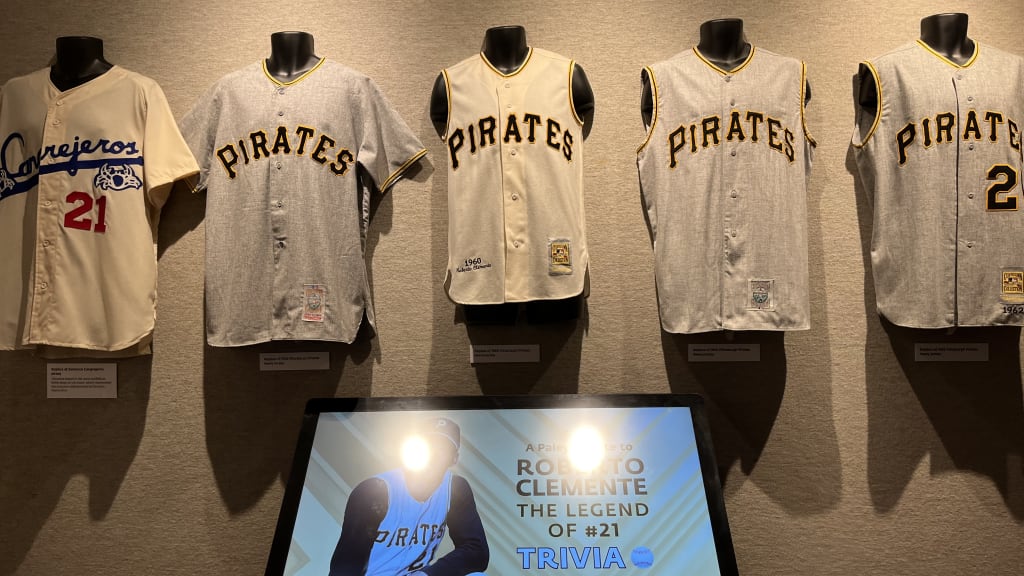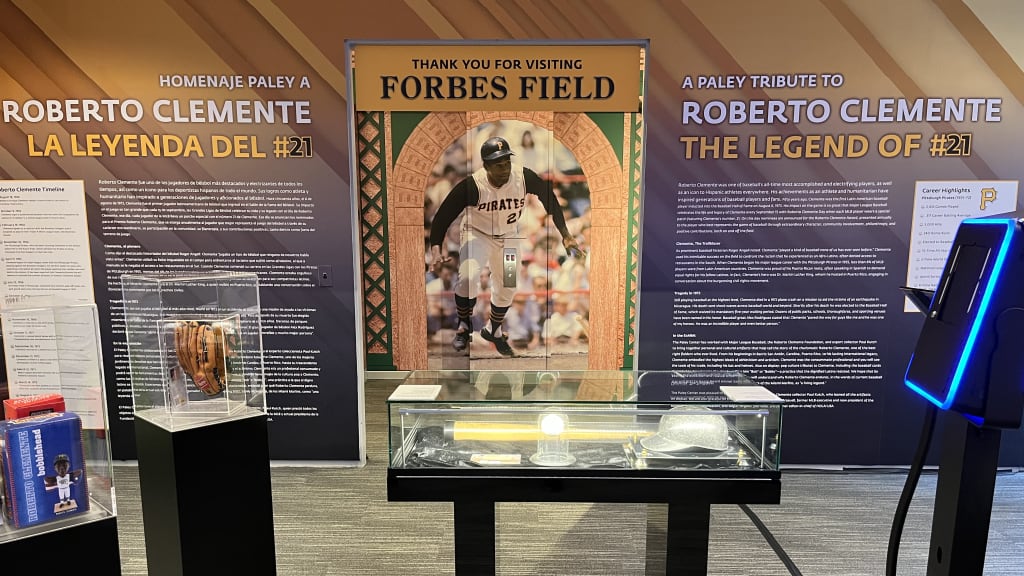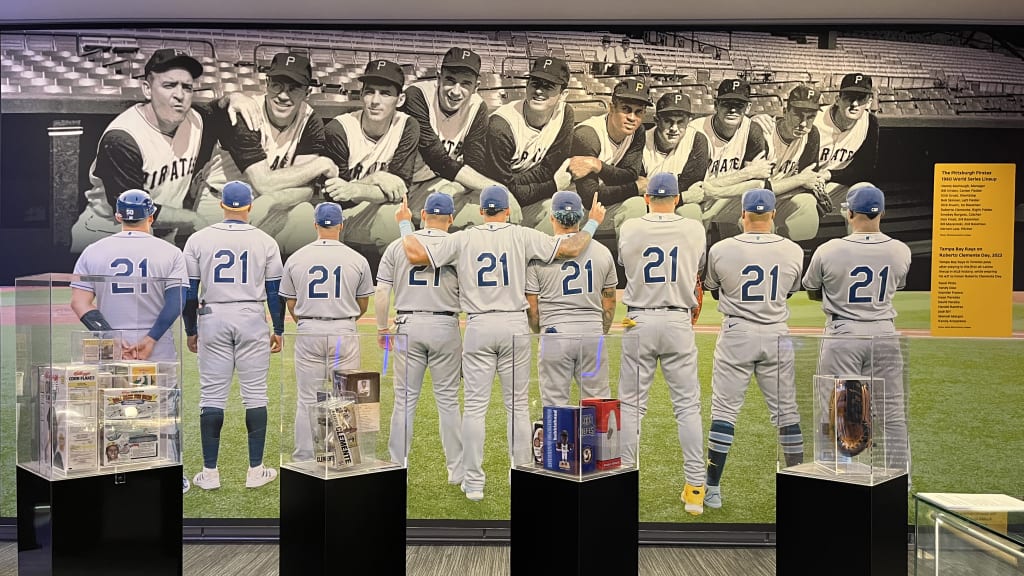
NEW YORK -- Television stars. Broadcasting legends. The most notable names in pop culture. Walk through the doors of the Paley Center for Media in midtown Manhattan, and those are the faces on display all over the walls of the main lobby.
From now through the end of October, front and center in the space is a raised stage with a wide-screen videoboard showing highlights of one of baseball’s greatest players: Hall of Famer Roberto Clemente. Next to it, in an enclosed case, is the Roberto Clemente Award presented by Capital One, a gift courtesy of Major League Baseball.
Bestowed annually to the player who best represents the game of baseball through extraordinary character, community involvement, philanthropy and positive contributions, both on and off the field, the Clemente Award will be given to one of 30 nominees from each club during this year’s World Series.
On Friday, MLB’s 22nd annual Roberto Clemente Day, the Paley Museum launched an exhibit entitled “Roberto Clemente: The Legend of #21,” marking the 50th anniversary of his induction into the Hall of Fame shortly after his tragic passing on a humanitarian mission to Nicaragua. Opening on the first day of Hispanic Heritage Month, the exhibit is also a nod to his standing as the first Latino player to be elected to the Hall.
“We wanted to tell the story of both the exceptional athlete and also an athlete who had a social conscious, who challenged the assumptions of the time and who makes a difference today for athletes in baseball but [everyone] everywhere,” said Ron Simon, the Paley Center’s head curator, who once met Clemente and got a signed autograph as a young boy growing up in Philadelphia in the mid-1960s.

The second floor of the museum, where the exhibit is housed, takes visitors back in time to Forbes Field in Pittsburgh, where Clemente played with the Pirates from his Major League debut in 1955 until ’70, when the team moved to Three Rivers Stadium for the final three seasons of his career. There is an authentic chair from Forbes Field’s opening in 1909, as well as one from Three Rivers Stadium’s debut in ’70, the latter of which guests can sit in and take photos.
On display throughout the exhibit are a collection of original artifacts from Clemente’s career, including a game-worn helmet from 1960 -- the year that the Pirates upset the Yankees in a seven-game World Series -- and a rare, autographed bat from ‘70.
The artifacts came from both Paul Kutch, a collector in Delaware who specializes in Clemente memorabilia, and the Roberto Clemente Foundation, which is run in large part by his sons: Luis, Enrique and Roberto Clemente Jr.
“We did work with the family. We certainly got their blessing,” Simon said. “They reviewed it and made sure that we got everything right. We’re very happy that we could work with the foundation, and we’re hoping that they will come.”
On the walls are replicas of Clemente’s Pirates jerseys, as well as one from Cangrejeros de Santurce, the team he began his professional career with at 18 years old in Puerto Rico, where he once shared an outfield with fellow Hall of Famer Willie Mays.

There are also pop culture relics such as Clemente cereal boxes, bobbleheads and trading cards, a testament to his place in the public sphere. They also shine light on his challenging role as an Afro-Latino ballplayer, with all but his rookie card calling him “Bob” or “Bobby,” the nickname he was often referred to as despite his resistance.
“He was dealing with a different world,” Simon said. “He called himself a double outsider as both Black [and] Hispanic. He didn’t know the language when he got here so he really couldn’t familiarize himself with the culture. And the baseball culture really didn’t understand the Hispanic ballplayer at that time. … He had a style and a flair that was so unique that baseball took a little bit more time to try to understand him.”
Inside the museum’s Goodson Theatre are daily screenings of five documentaries that tell Clemente’s story in more depth: MLB’s “Beisbol: The Latin Game” (2007), PBS’s “American Experience: Roberto Clemente” (2008), FOX Sports’ “Clemente” (1998), ESPN Classic’s “SportsCentury: Roberto Clemente” (2002) and “ESPN Perfiles: Roberto Clemente” (2007), which is in Spanish with English subtitles.
Mined from the Paley Archive -- the largest public collection of its kind with over 160,000 programs spanning more than 100 years -- the documentaries explore the achievements and activism that have made Clemente a unique, lasting figure in the game’s history.

When Clemente won his first World Series in 1960, he was the only person of color in the starting lineup. In 1971, the year he claimed World Series MVP honors as the Pirates topped the Orioles in another seven-game Fall Classic, he was also part of a lineup composed entirely of Black and Afro-Latino players, which is believed to be the first all-minority lineup in AL/NL history.
On Roberto Clemente Day 2022, with more than 30 percent of MLB comprised of Hispanic players, the Rays put together the first all-Latino lineup in AL/NL history.
The centerpiece of the exhibit is a mural dedicated to that parallel, with the Rays -- who were all donning No. 21 uniforms -- standing in a line, looking up at Clemente alongside his 1960 Pirates.

A tangible sign of just how far the game has come.
“[It’s] to understand how inspirational Clemente has been to baseball, and still is,” Simon said. “He was so important and misunderstood in the beginning, certainly among Pittsburgh writers, but then is one of the icons of the game. An icon as a tremendous athlete, but also as a man who had to battle various aspects of the game and lead the way for another generation.”
